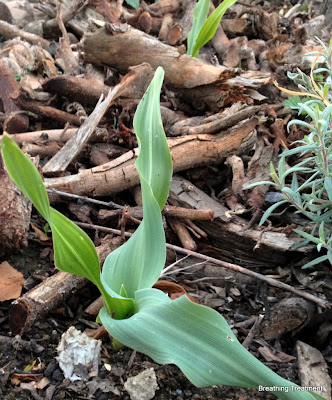The ones I planted at my house are also in a rectangular trough and in numerous smaller circular planters.
 |
| C. sativus (Saffron Crocus) in foreground. Calochortus venustus (Butterfly Mariposa Lily) is in far circular pot. |
Thinking about C. sativus re-stimulated my interest in native bulbs. I have enduring memories of coming across Lilium, Brodiaea, and Calochortus species while hiking. They seem so unexpectedly beautiful to me. Why couldn't I have some of that in my yard?
I thought I could scratch my itch with Allium unifolium (One-leaf Onion, which is mostly grown as an ornamental rather than a food plant) and I already had gathered seed at my previous house. A. unifolium is also available as a bulb, but I think that you can't really call yourself a gardener if you don't start plants from seed occasionally. Plus there's no added cost with seed you gather yourself (beyond the hundreds of dollars you'll spend in time and energy monitoring your plant babies). I soon learned why it's somewhat uncommon for most gardeners to start bulbs from seed: Allium can take up to a year or two to sprout, particularly if the seed is old. Even if you sprout the first year, there's usually a whole year of waiting while the first bulbs develop. Sure enough, as of 1/22 I'd only sprouted a weed. Allium seed that could sit around doing nothing for a year or more didn't satisfy me for long, and so the saga of late season bulb acquisition began in which I tried to get all sorts of bulbs with that urgent sense of desperation that comes from knowing that I'd miss a whole year of growing if I didn't get it done RIGHT NOW. Consequently, planning went
Two Chlorogalum pomeridianum (Soap Root), did make it into the yard where they are sprouting nicely - it looks like my gardener took the top off of one of them (background in photo below and not shown), but it seems otherwise healthy. I saw these in abundance hiking in the Malibu mountains, a possible ethonobotanic remnant of the native people who lived there once and used them as soap, for food, and a host of other uses.
In rapid order came Calochortus venustus (Butterfly Mariposa Lily) (not shown).
Then came Tritelia that Juli had been nursing in a pot at her house. With her benign neglect it had multiplied, but she did not want to give any up since she liked them so much. I replanted them in a larger pot at her house. They are flourishing with occasional added water. (also not shown)
 |
| Some of my newly planted bulbs. Smaller circular pots containing Crocus sativus were intended as gifts but didn't quite make it. Coming to a gift giving holiday near you soon! |
I also managed to put my mitts on Bloomeria crocea (aka Golden Stars -Two short pots at left) and Calochortus catalinea ( Catalina mariposa lily - Two pale turquoise and one small basic clay pot at right) quite late in the season thanks to Tony Baker at Natural Landscapes. The other pots contain C. Sativus (7 small circular pots in mostly metallic colors), an unnamed Roger's Red offspring (far left, also from Tony Baker), and Mirabilis californica (California four o'clock, wishbone bush - square pot at left). Allium is in the tallest basic clay pot with gravel mulch (top center).
The bulbs are sometimes only subtly different at this stage.
 |
| Calochortus venustus (Butterfly Mariposa Lily). One of these has a different look. |
 |
| This Calochortus venustus (Butterfly Mariposa Lily) has different leaf texture and shape than its siblings. |
 |
| Calochortus catalinea (Catalina mariposa lily). Leaf size and color has slight differences from Calochortus venustus. Growth habit seems a bit more upright. |

Do you have to expose your croci bulbs and seeds to a fake Winter, ie. the fridge, in order to kick start the growing instinct?
ReplyDeleteI would bet the answer is no, since these are all California natives and they seem to grow well in many wild places where we don't have freezing weather. Since it's my first year with many of these varieties, I'll have to give a report later in the year on their blooms.
ReplyDelete